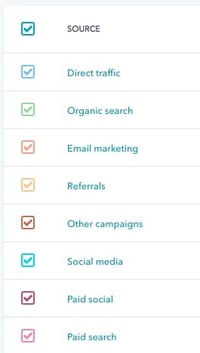In digital marketing, return on investment is a crucial business metric that shouldn’t be disregarded. There are many different kinds of integrated marketing channels accessible, ranging from email lists and social media to paid advertisements and comprehensive SEO. Companies must use these channels to their full potential and take the necessary precautions to maintain an optimal return on investment if they hope to see steady growth.
But which marketing strategy affects overall return on investment the most?
Return on Investment (ROI) is the term used to describe the profit or loss that results from your campaign efforts in the world of digital marketing. A positive ROI basically means that a campaign is making more money than what was spent, and vice versa for a negative ROI. In general, digital marketers should aim for an average ROI of 5:1, which is $5 gained for every $1 spent on a marketing campaign.
If this isn’t good enough, raise the bar a little bit! Exceptional marketing ROI is defined as 10:1 or higher. Achieving this goal will probably take more resources and expertise, but it is still possible. On the other hand, an ROI below 2:1 is non-profitable and indicates your marketing strategy needs some work.
To assess the effectiveness of your initiatives in digital marketing, measuring return on investment is essential. If not, you can be squandering your money and marketing “blindly.” Naturally, the type of campaign and other influencing elements will affect ROI. However, by examining the outcomes, you’ll be able to move forward with confidence and take concrete actions. Your campaigns will perform better the more you understand marketing ROI.
To help you design your marketing strategy, we will go over which online marketing efforts offer the highest return on investment in this post.
For your digital marketing plan to be successful over the long run, using the appropriate metrics to calculate ROI is essential. Although it’s not difficult to utilize sales income as a statistic, not all digital marketing initiatives are directed toward generating direct sales. Prior to closing a deal, certain channels—like content marketing—seek to increase brand recognition or guide clients through the buying process.
- define primary goal
- choose one metric
- assign value to the metric
Is your digital marketing strategy designed to generate leads, increase brand awareness, and engage customers in social media? While you may have more than one goal, you need to define a primary goal and a single metric you can use to track it.
If your goal is to generate qualified leads, then your metric would be the number of qualified leads captured. Other metrics, such as website visits, while important would not be included in your ROI calculation because they did not directly contribute to your primary goal.
Once you select a metric, you need to assign a value to it. But how much is a share on social media worth or a website visit? Your sales and marketing teams, as well as the digital marketing agency you’re working with, can help you calculate these values.
A simple example: for a digital marketing campaign whose goal is to increase website traffic, the metric would be unique visitors; spending $1,000 on ads that send 10,000 people to your website means your ROI would be 10,000 visits divided by $1,000, or 10 visits per dollar.
Let’s now explore a few different campaign strategies that are known for their positive ROI. We’ll explain the pros and cons of each to ultimately decide which strategy offers the best revenue return.
1. Search Engine Optimization
Search engine optimization, or SEO, is one of the most successful and widely used digital marketing strategies for growth. When properly executed, SEO marketing can deliver impressive results at a very low cost.
SEO marketing has an average ROI of 22:1 — that’s 2,200 percent!
Effective SEO can give businesses huge opportunities for driving traffic to their website. Plus, the results are long-term. Your site has the potential to continually grow in rankings over the years, delivering positive ROI with little to no effort on your end. For these reasons and more, SEO remains one of the top online marketing strategies for ROI.
2. Email Marketing
Email marketing is reported as one of the highest ROI digital marketing strategies. It’s a well-known method that requires some initial investment but has high success when it comes to exposing your brand to customers.
Email marketing has an average ROI of 42:1 — that’s 4,200 percent!
So, in theory, for every $1 spent on email marketing, you’ll make $42 in return. It’s no wonder why this method is so popular amongst digital marketers. Creating contact lists and sending out emails is relatively cost- and time-effective when compared to other campaign methods. Also, campaign effeteness will only increase as you expand your audience and grow your email list. In addition, email marketing can be used in conjunction with other online marketing strategies for maximum effectiveness.
The primary drawback of email marketing is the fact that it requires having access to a substantial database of customer emails. Tips for building a sizable contact list include using subscription incentives, sign-up lists, and giving customers the ability to create on-site accounts. Follow these steps, and in time, you can expect results and substantial business growth.
If you are going to run an email campaign, you should consider measuring these metrics when calculating your digital marketing ROI:
- Open rate
- Conversions
- Click-through rate (CTR)
- Unsubscribe rate
- Bounce rate
- Leads acquired
3. Social Media Marketing
Social media marketing is another effective marketing channel that doesn’t require a huge budget or amount of time to succeed. Depending on the extent of your campaign, you can spend hundreds or thousands of dollars per month.
Social media marketing offers several valuable benefits that affect ROI, including:
- Helps customers discover new products
- Sparks positive interactions with consumers
- Provides customer service and engages with followers
- Increases brand traffic and obtains new customers
- Contributes to overall marketing strategy
Measuring social media ROI is a bit more complex than measuring the results you’ll get from other types of digital marketing tactics. In social media marketing, you can determine campaign effectiveness by measuring specific metrics. Below we listed the top metrics marketers use to measure the ROI of social media campaigns.
- Engagement rates
- Click-through rate (CTR)
- Clicks
- Conversions
- Leads acquired
- New followers
4. PPC Marketing
When done right, PPC services will generate a positive ROI in digital marketing.
Return on ad spend (ROAS) is much simpler to calculate than the overall ROI for PPC campaigns. The formula is essentially the same as the ROI formula we mentioned previously; it just replaces “marketing” with “PPC.”
This value, however, does not factor in all costs—just the cost of the paid ads. If you want a more precise estimate of your PPC campaign’s profitability, you’ll want to factor in some additional costs, such as:
- technology & equipment
- credit card processing fees
- fulfillment
- employee salaries
Unlike SEO marketing, PPC advertising is not long-term; once you turn the ads off, the campaign is over. The only lasting value is the sales from the ads while they were still active.
How to Create a Digital Marketing Strategy
1. Build your buyer personas.
For any marketing strategy – digital or not – you need to know who you’re marketing to. The best digital marketing strategies are built upon detailed buyer personas, and your first step is to create them. Buyer personas represent your ideal customer(s) and can be created by researching, surveying, and interviewing your business’s target audience.
Read Also: RTB in Marketing: Why You Should be Using it
It’s important to note that this information should be based upon real data whenever possible, as making assumptions about your audience can cause your marketing strategy to move in the wrong direction.
To get a rounded picture of your persona, your research pool should include a mixture of customers, prospects, and people outside your contacts database who align with your target audience.
But what kind of information should you gather for your own buyer persona(s) to inform your digital marketing strategy? That depends on your business — it‘s likely to vary depending on whether you’re B2B or B2C, or whether you sell a high-cost or low-cost product.
2. Identify your goals and the digital marketing tools you’ll need.
Your marketing goals should always be tied back to the fundamental goals of your business. For example, if your business‘s goal is to increase online revenue by 20%, your marketing team’s goal might be to generate 50% more leads via the website than the previous year to contribute to that success.
Whatever your overarching digital marketing goal is, you must be able to measure the success of your strategy along the way with the right digital marketing tools. For instance, the Reporting Dashboard in HubSpot brings all of your marketing and sales data into one place, so you can quickly determine what works and what doesn’t to improve your strategy for the future.
3. Evaluate your existing digital channels and assets.
When reviewing your existing digital marketing channels and assets to determine what to incorporate in your strategy, it’s helpful to first consider the big picture — this will prevent you from feeling overwhelmed or confused.
Gather what you have, and categorize each vehicle or asset in a spreadsheet, so you have a clear picture of your existing owned, earned, and paid media.
Owned, Earned, Paid Media Framework
To do this effectively, use the owned, earned, and paid media framework to categorize the digital “vehicles,” assets, or channels you‘re already using and decide what’s a good fit for your strategy.
- Owned Media
This refers to the digital assets your brand or company owns — whether that’s your website, social media profiles, blog content, or imagery. Owned channels are what your business has complete control over.
This can also include some off-site content you own that isn’t hosted on your website (e.g. a blog you publish on Medium).
- Earned Media
Earned media refers to the exposure you earn through word-of-mouth marketing. Whether that‘s content you’ve distributed on other websites (e.g. guest posts), PR work you‘ve been doing, or the customer experience you’ve delivered. Earned media is the recognition you receive as a result of these efforts.
You can earn media by getting press mentions and positive reviews as well as by people sharing your content via their networks (e.g. social media channels).
- Paid Media
Paid media refers to any vehicle or channel you spend money on to catch the attention of your buyer personas. This includes things like Google Ads, paid social media posts, native advertising (e.g. sponsored posts on other websites), or any other medium through which you pay in exchange for increased visibility.
4. Audit and plan your owned media campaigns.
At the heart of digital marketing is owned media — and it almost always comes in the form of content. That‘s because nearly every message your brand broadcasts can be classified as content, whether it’s an About Us site page, product descriptions, blog posts, ebooks, infographics, podcasts, or social media posts.
Content helps convert your website visitors into leads and customers while improving your brand’s online presence. And when this content is search engine optimized (SEO), it can boost your search and organic traffic.
Whatever your digital marketing strategy goal is, you’ll want to incorporate owned content. To start, decide what content will help you reach your goals.
If your goal is to generate 50% more leads via the website than last year, your About Us page is most likely not going to be included in your strategy, unless that page has somehow been a lead-generation machine in the past.
Here’s a brief process you can follow to work out what owned content you need to meet your digital marketing strategy goals.
- Audit your existing content.
Make a list of your existing owned content, and rank each item according to what has previously performed best in relation to your current goals. For example, if your goal is lead generation, rank your content according to which pieces generated the most leads over the last year (such as a blog post, ebook, or site page).
The idea here is to figure out what‘s currently working, and what’s not so that you can set yourself up for success when planning future content.
- Identify gaps in your existing content.
Based on your buyer personas, identify any gaps in the content you have. For example, if you’re a math tutoring company and know through research that a major challenge for your personas is finding effective ways to study, create some.
By looking at your content audit, you might discover that ebooks hosted on a certain type of landing page convert really well (better than webinars, for example).
In the case of this math tutoring company, you might make the decision to add an ebook about “how to make studying more effective” to your content creation plans.
- Create a content creation plan.
Based on your findings and the gaps you‘ve identified, make a content creation plan outlining the content that’s necessary to help you hit your goals.
This should include:
- A title
- Format
- A goal
- Promotional channels
- Why you’re creating the content
- The priority level of the content
This can be a simple spreadsheet, and should also include budget information if you‘re planning to outsource the content creation, or a time estimate if you’re producing it yourself.
5. Audit and plan your earned media campaigns.
Evaluating your previous earned media against your current goals can help you get an idea of where to focus your time. Look at where your traffic and leads are coming from (if that’s your goal) and rank each earned media source from most effective to least effective.
You can obtain this information using tools like the Sources reports in HubSpot’s Traffic Analytics tool.

You may find a particular article you contributed to the industry press drove a lot of qualified traffic to your website, which boosted conversions. Or, you may discover LinkedIn is where you see most people sharing content, which increases traffic.
The idea is to build a picture of what types of earned media will help you reach your goals (and what won‘t) based on historical data. However, if there’s something new you want to experiment with, don‘t rule it out just because it’s never been done before.
6. Audit and plan your paid media campaigns.
This process involves much of the same process: You need to evaluate your existing paid media across each platform (e.g. Google Ads, Facebook, Twitter, etc.) to figure out what’s most likely to help you meet your current goals.
If you‘ve spent a lot of money on Ads and haven’t seen the results you‘d hoped for, maybe it’s time to refine your approach, or scrap it altogether and focus on another platform that seems to be yielding better results.
By the end of the process, you should have a clear idea of which paid media platforms you want to continue using, and which (if any) you’d like to remove from your strategy.
7. Bring your digital marketing campaign together.
You’ve done the planning and the research, and you now have a solid vision of the elements that will make up your digital marketing strategy.
To review, here’s what you should have solidified so far:
- Clear profile(s) of your buyer persona(s)
- One or more digital marketing-specific goals
- An inventory of your existing owned, earned, and paid media
- An audit of your existing owned, earned, and paid media
- An owned content creation plan or wish list
To provide a better understanding of what digital strategies entail, check out the following list of basic marketing strategies commonly utilized by teams across a range of industries. A better understanding of what digital marketing strategies entail is vital to your ultimate success. Earning a bachelor’s in marketing or a related field can be valuable and boost your career.
Lastly
You have to tailor your plan document specifically to your company, thus it is very difficult for you to develop a digital marketing strategy template that works for everyone.
Recall that the goal of your strategy document is to outline the steps you will take to accomplish your goal over time; if it effectively conveys this, you have mastered the fundamentals of developing a digital strategy.


